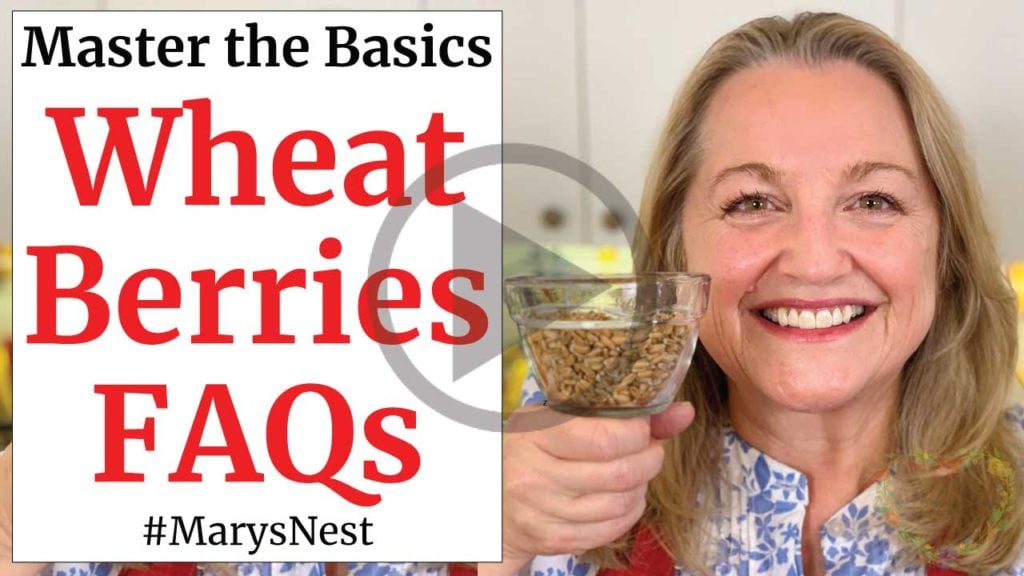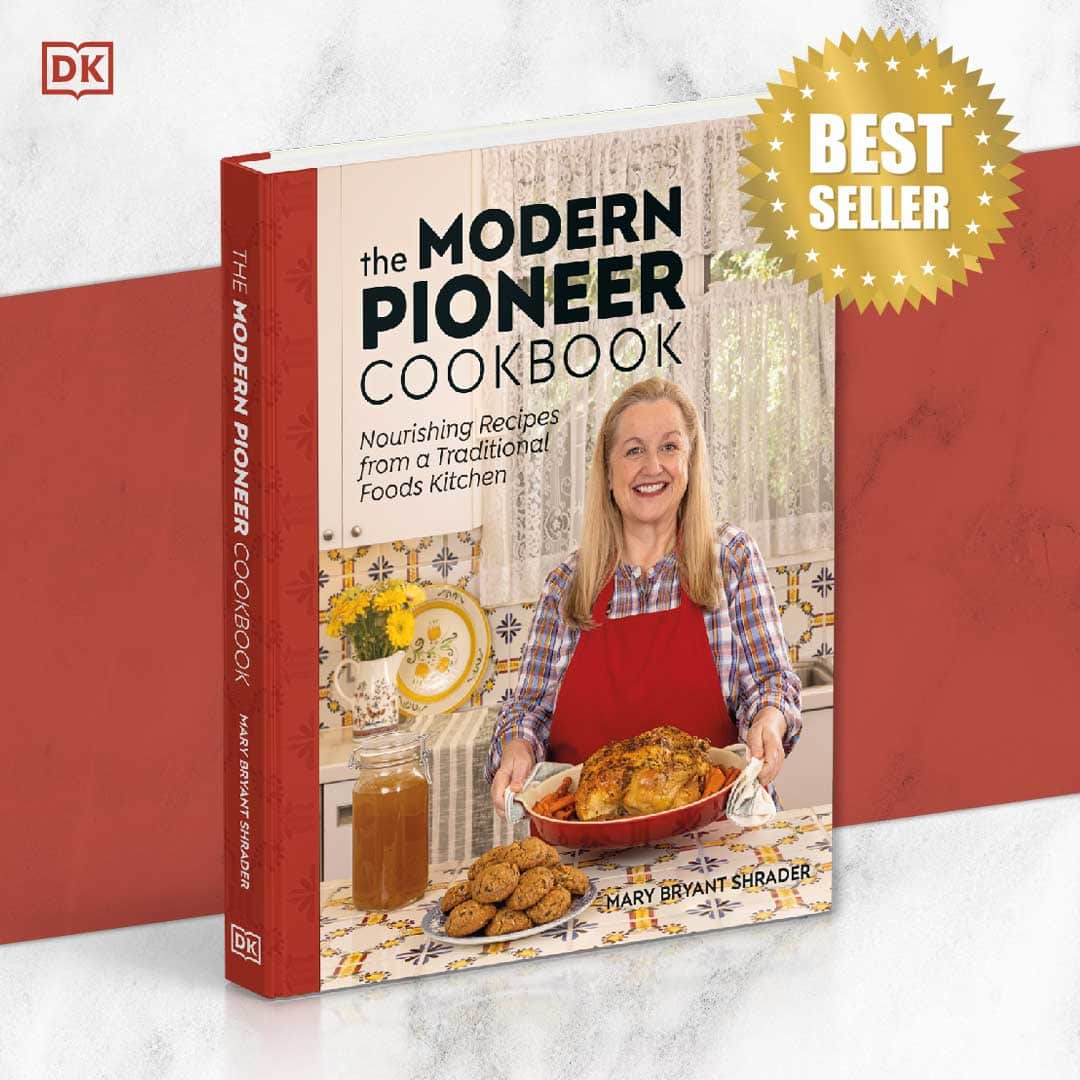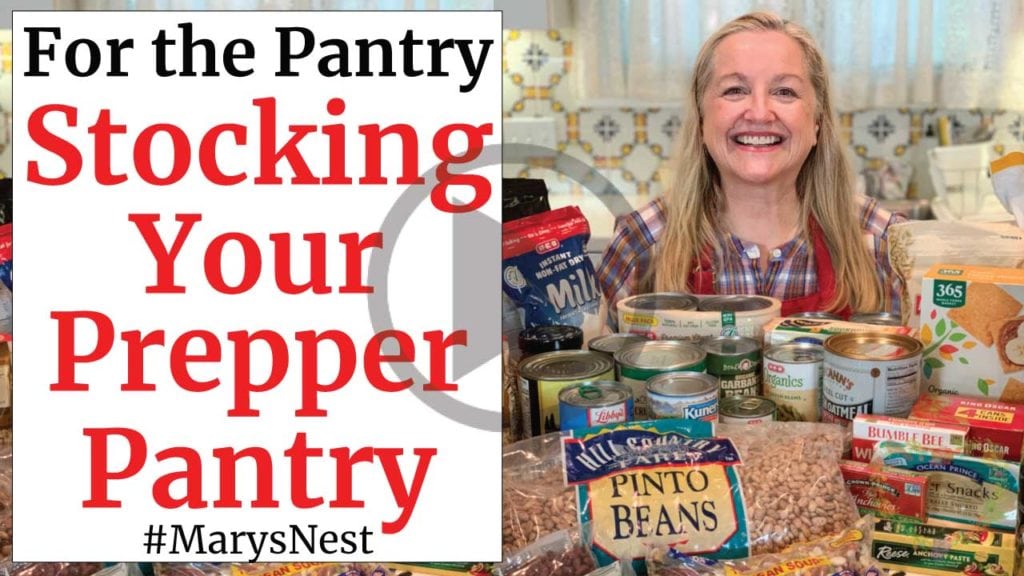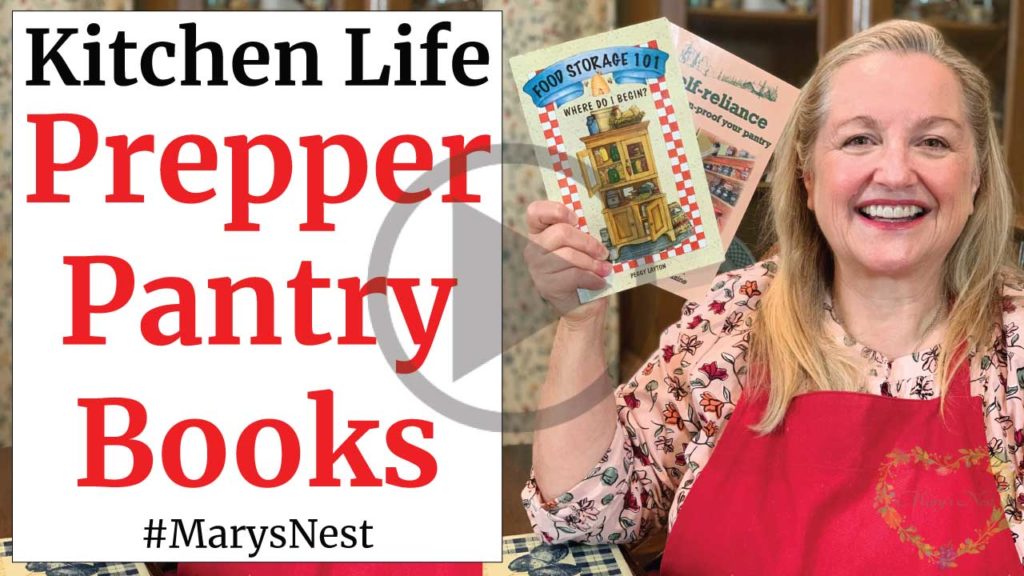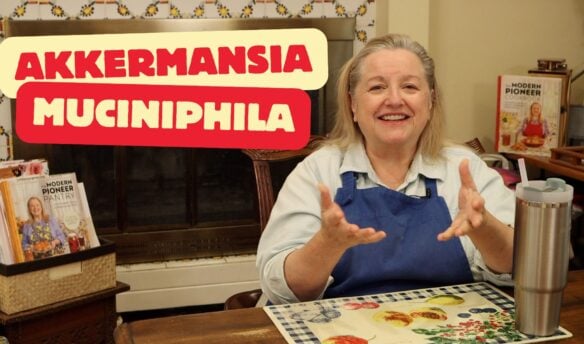Today, I want to share with you why you should be storing whole grain in your Prepper Pantry. And once you have whole grain, you’ll need to be able to grind it into flour. But don’t worry. I have three options for you to make homemade flour!

Affiliates note: As an Amazon Associate I earn from qualifying purchases. My content may contain affiliate links to products and services. If you click through and make a purchase, I’ll receive a small commission. It does not affect the price you pay.
Table of Contents
- Whole Grain for the Prepper Pantry
- Are Whole Grains a Forever Food?
- What Types of Whole Grain Can You Store?
- How Best to Store Whole Grains
- The Modern Pioneer Cookbook
- Download Your Free 36-Page Pantry List
- Grind Your Own Flour with the Mockmill
- Vitamix
- WonderMill
- More Prepper Pantry videos
- Join the Traditional Foods Kitchen Academy
- Kitchen Academy Videos
- Shop for items used in this blog post or video
Whole Grain for the Prepper Pantry
Over the last couple of months, I have shared lots of information with you on how to best stock your Extended Pantry—what we also refer to as the Prepper Pantry. This section of your Four Corners Pantry (which I discuss in detail below) is where you want to store those foods that serve as a backup supply for your Working Pantry, which is the pantry you access on a regular basis.
Now keep in mind, what we store in our Prepper Pantry helps to restock our Working Pantry, but we also want to make sure that we keep foods in our Prepper Pantry that can help us in the event of a dire emergency when food may not be plentiful or readily available. For this purpose, I have put together a video where I discuss the Forever Foods that meet this specific need.
Are Whole Grains a Forever Food?
But where do whole grains fit in? Yes, some may consider them a Forever Food, but practically speaking, whole grains—when stored properly —can last anywhere from 8 years to 25+ years. Why such a broad range? You’ll learn more about the different types of whole grains that you can store in the next section, so read on.
In today’s grinding grain tutorial video, I share a more in-depth discussion as to why you should be storing whole grain in your Prepper Pantry, as opposed to whole grain flour. I also talk about how whole grain can serve both as a source of food to restock your working pantry, as well as a food that is perfect for long term storage.
When compared to whole grain flour, which at best may stay fresh up to no more than one year and is generally only really considered fresh for about six months, whole grain wins as your best long-term storage option.
What Types of Whole Grain Can You Store?
A nice feature about storing whole grain in your Prepper Pantry is that you have an abundance of choices. You can store both soft whole grain and hard whole grain. Your soft whole grains include:
- Barley, Hulled or Pearled
- Oats, Oat Groats, Rolled Oats
- Quinoa
- Rye Berries, and
- Soft White Wheat
These soft whole grains, when stored properly, can stay fresh for at least eight years and often up to 10 years.
Your hard grains include:
- Buckwheat
- Dry Corn
- Flax
- Kamut
- Millet
- Durum Wheat
- Hard Red and Hard White Wheat
- Spelt
- Triticale
These hard whole grains, when stored properly, can stay fresh for up to at least 25 years—maybe longer!
In the following videos, I also talk more about the different wheat berries and Kamut.
How Best to Store Whole Grains
When it comes to how best to store whole grain, you have lots of options. Some of my favorite ways to store whole grain include 5-gallon storage buckets with gamma lids, mylar bags, and glass jars with an airtight seal.
I teach you everything you ever wanted to know about long-term storage options in the following detailed videos. Plus, in each corresponding blog post, I share lots of links to authoritative sources on food storage for more detailed information.
In my Best Food Storage Supplies for Your Prepper Pantry video, I share some clever ideas for using 5-gallon storage buckets in conjunction with mylar bags to rodent-proof—as best as possible—your whole grain.
And when it comes to bugs…don’t worry! I’ve got you covered. I share all the information you need for how to deter bugs, as well as options for how to kill them before they become a problem.
Start Your Traditional Foods Journey
Part of my passion for keeping traditional cooking skills alive—in addition to my online cooking school on YouTube—is writing cookbooks. My first book, The Modern Pioneer Cookbook published by Penguin Random House (PRH), is full of my traditional foods recipes that show you how to create a traditional foods kitchen.
Be sure to order your copy of my bestselling book, The Modern Pioneer Cookbook, to start your traditional foods journey. And stay tuned for my next cookbook that will be published by PRH in 2025!
Download Your Free 36-Page Pantry List
For an extensive list of the traditional foods you can make and purchase to stock your pantry, be sure to download my free 36-page Traditional Foods Pantry List. This comprehensive eBook is full of links to recipe videos, helpful articles, and more!
Grind Your Own Flour with the Mockmill
When it comes to electric grain mills, after I did A LOT of research, I decided to buy a Mockmill. And am I so happy I did! The Mockmill is a very affordable but beautifully crafted German-made mill that stone grinds grain with settings ranging from 1 to 10—fine to coarse ground grain.
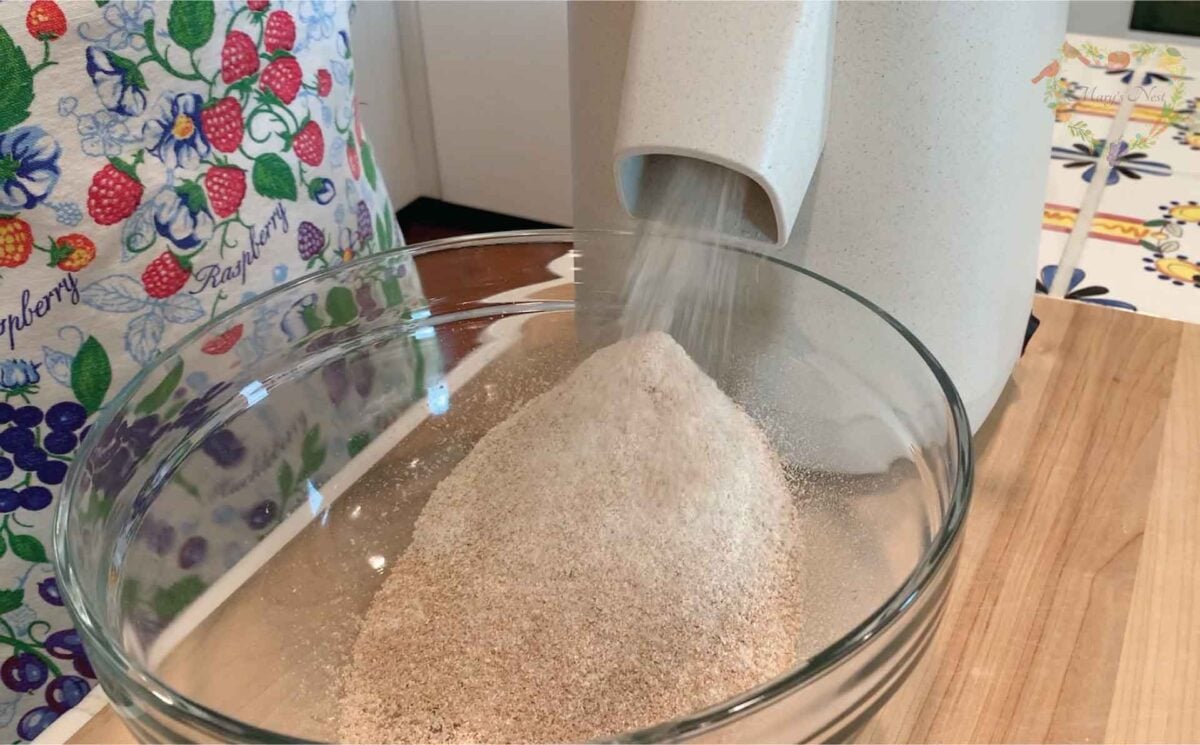
Learn more about Mockmill electric grain mills for making fresh flour and their Flake Lover’s Flaker that flakes whole grain in minutes. (This is not a sponsored post, I bought the Mockmill products that I show you, and I’m a happy user of their devices in my kitchen.)
- Mockmill 100 Grain Mill unboxing
- Get the Mockmill 100 Stone Grain Mill (Same product I show you in my unboxing video.)
- Flake Lover’s Flaker from Mockmill in action (Using this device, you can flake whole grain in minutes.)
Vitamix
When you watch today’s tutorial video that corresponds with this blog post, you will get to see my 30-year-old Vitamix in action. Yes, I purchased it 30 years ago, and it’s still going strong. Although I can grind grain in it, I defer to my Mockmill since it is a stone ground grain mill, which is best for keeping the naturally occurring oils in whole grains fresh.
However, if you are interested in using a modern-day Vitamix to grind your whole grain, be sure to watch my tutorial video because I share a few tips on how to use your Vitamix. For example, I discuss how to keep your grain cool and protect those natural oils when grinding grain in a Vitamix. You’ll also learn when you may need to make the jump and invest in the Vitamix Dry Grains Container accessory.
WonderMill
Oh, the WonderMill! It is a wonder! The WonderMill Junior, which is what I purchased, is a manual grain mill. And although it does take a bit of elbow grease to use, you never have to worry when the power is out. You can still grind your grain. I love mine and am very happy I have this is a backup to my electric Mockmill.
If you add the flywheel attachment in place of the standard handle, it makes it easier to grind your grain. And if you have kids, they’ll love helping you with this chore. Many a boy has been known to pretend he is driving a race car!
UPDATE: As of the writing of this blog post, the WonderMill Junior is out of stock. Lehman’s also carries their own brand of manual grain mill, but that too right now is out of stock! Be sure to check back often as to see when these manual grain mills are back in stock. Other options for manual grain mills that are available are the Country Living Grain Mill and the Quaker City Grain Mill. (Both are in currently stock at Lehman’s and both are USA made. Be sure to use my Lehman’s discount code when you order.)
More Prepper Pantry videos
In case you have not seen my previous Prepper Pantry videos, you can catch-up now with the videos below. These detailed videos will have you well on your way to stocking your Prepper Pantry, and you’ll never be unprepared again!
Join the Traditional Foods Kitchen Academy
Are you looking for more traditional foods videos? If so, I invite you to join the Traditional Foods Kitchen Academy. Members of this optional paid YouTube community get access to exclusive videos and other members-only perks. Plus, your YouTube comments include a special members-only badge.
Kitchen Academy Videos
The Only Traditional Recipes You’ll Ever Need!
Focus on traditional recipes with real food. Don’t chase trends.
Let’s Talk Akkermansia: A Tiny Helper for Big Gut Health
Discover how Akkermansia muciniphila supports gut and immune health—and how traditional foods help this mighty microbe thrive.
How to Eat a Mediterranean Diet with a Keto Twist
Explore a Mediterranean-Keto twist with a full sample menu focused on healthy fats, quality proteins, and low-carb veggies.
Stay in Touch with Mary’s Nest
- Subscribe to My YouTube Channel for Traditional Foods Videos (Free) - When you subscribe, be sure to click on the notification bell that will let you know each time I upload a new video.
- Subscribe to Mary’s Traditional Foods Newsletter (Free) - Get a free 36-page eBook for signing up: How to Stock Your Essential Traditional Foods Four-Corners Pantry.
- Join the Traditional Foods Kitchen Academy - For more detailed videos and exclusive members-only perks, join my YouTube membership community.
- Order The Modern Pioneer Cookbook - Get a hardcover book of Mary's nourishing recipes from a Traditional Foods Kitchen. This bestselling cookbook is published by Penguin Random House with their DK imprint.
- Preorder The Modern Pioneer Pantry - Be one of the first to get Mary's hardcover book about preserving food and making delicious meals from your Four Corners Pantry. Mary's second cookbook is also published by Penguin Random House.
I look forward to having you join me in my Texas Hill Country Kitchen!
Shop for items used in this blog post or video
Favorite Mockmill Products
- Mockmill 100 Stone Grain Mill
- Mockmill 200 Stone Grain Mill
- Mockmill Stone Grain Mill Attachment For Stand Mixers
Favorite Vitamix Products
Favorite Manual Grain Grinders
Favorite Whole Grains and Supplies
- Fine Mesh Strainer
- Einkorn Berries
- Spelt Berries
- Whole Wheat Berries
- White Whole Wheat Berries
- Rye Berries
- Oat Groats
Favorite Food Storage Supplies
- 5 Gallon Bucket w/ Lid
- Gamma Lid
- 5 Gallon Mylar Bag
- 500CC Oxygen Absorbers
- 10g Silica Gel Packs
- Bay Leaves
Favorite Kitchen Supplies
- Favorite Aprons
- Spice Grinder
- Countertop Burner (On my kitchen island in many recipe videos.)
- Handheld Vacuum Sealing System
- Vacuum Lids
- Whisk
- Silica Gel Packets (Helps keep moisture from building up in your mix)
- Cast Iron Dutch Oven
- 8-Quart Slow-Cooker
- Fat Separator (Clever kitchen device to help you decant bone broth)
- Flour Sack Towels
- pH Strips (Helps you check on the acidity of your vinegar)
Amazon Shop and Shopping Guide
- Visit Mary’s Nest Amazon Shop
- Visit my Shopping Guide page
Get up to 15% off for stocking your Traditional Foods Pantry and equipping your Modern Pioneer Kitchen, including discounts from US Wellness Meats, Farmhouse Teas, Lehman's, Masontops, Cultures for Health, Survival Garden Seeds, Redmond Real Salt, Plan to Eat, and More!
Recommended Reading
- The Modern Pioneer Cookbook
- Nourishing Traditions
- Emergency Food Storage & Survival Handbook: Everything You Need to Know to Keep Your Family Safe in a Crisis
- Food Storage 101 Where do I begin? (Cookin’ With Home Storage)
- Prepper’s Pantry: Build a Nutritious Stockpile to Survive Blizzards, Blackouts, Hurricanes, Pandemics, Economic Collapse, or Any Other Disasters

